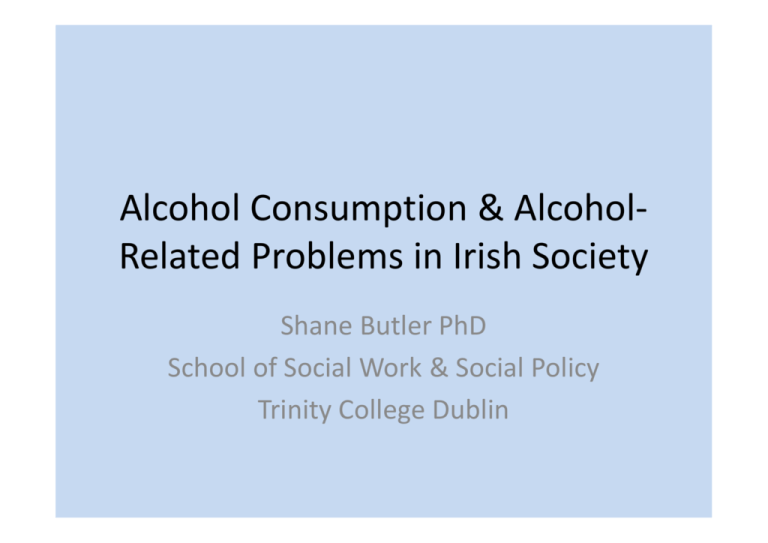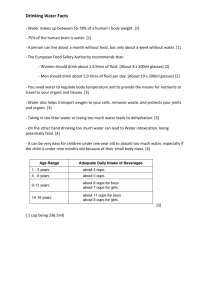
Alcohol Consumption & AlcoholRelated Problems in Irish Society
Shane Butler PhD
School of Social Work & Social Policy
Trinity College Dublin
The World Health Organization View of
Alcohol-Related Problems
• The prevalence of alcohol-related problems in
any society is primarily determined by the
average volume consumed and the pattern of
consumption (with the ‘binge’ pattern identified
as being especially risky
• The problematic properties of alcohol are: 1) it is
toxic; 2) it intoxicates (i.e. makes people drunk);
3) creates dependence or addiction
• Alcohol causes or contributes to a spectrum of
acute and chronic health and social problems
Sociological Perspectives on Alcohol
Consumption
• Social scientists typically reject what they see as
‘reductionist’ biomedical explanations of drinking
experiences and argue for the use of multidisciplinary
explanatory frameworks
• A popular framework is that known as: Drug
(pharmacological), Set (psychological) and Setting
(sociological)
• What this means is that the drug/alcohol experience is
not explicable solely in pharmacological terms, but
must explore the expectations of individual consumers
and the social & cultural context in which consumption
occurs
Ireland as a Drinking Society
• Levine (1992) distinguishes between ‘temperance cultures’ and
‘non-temperance cultures’
• Temperance cultures are found in those societies which in late-19th
and early-20th centuries developed large & enduring religious
temperance movements based on the idea that alcohol is
inherently evil
• Temperance cultures are found in predominantly Protestant
societies where a large proportion of alcohol consumed is in spirits
form
• Ireland has not, and never had, a temperance culture – the Fr
Mathew movement (1830s) did not last long, and the Pioneer
Association (founded 1898) is ideologically moderate
• The stereotype of the Irish as heavy drinkers would seem to be
broadly valid – with disposable income being a key factor in
determining consumption volumes
The Bachelor Drinking Group
•
•
•
•
•
•
Historians and social scientists (e.g. Stivers, 1976) have explored the
meaning of alcohol consumption within Irish society from the early-19th
century onwards
This concept describes and explains how men drank with other men in
public houses – in a situation where a single inheritance farm economy
left many men unable to marry, and because of the sexual mores of the
time, untitled to a sex life
The bachelor drinking group valued male bonding and heavy communal
drinking more than marriage or the company of women
Married men often rejoined the group
For those concerned with present-day alcohol consumption and its
relationship with sexual assaults on women, it is salutary to remember
that the bachelor drinking group provided a safety valve in a society with
large numbers of compulsorily celibate men
Where heavy drinking was an acceptable substitute for heterosexual
intercourse, the teetotaler was the person suspected of sexual deviance
Changes in Irish Drinking – from the
1960s
•
•
•
•
•
The Pioneer Association began to lose numbers and to become unsure of
its role and function in Irish society (Ferriter, 1999)
Women began to drink in increasing numbers, and traditional maleoriented pubs were adapted or replaced by ‘lounge bars’
The drinks industry began to market products aimed at women
The disease concept of alcoholism was regarded as being scientifically
authoritative, and it was widely assumed that drinkers could be
categorically divided into social drinkers (allegedly 90% of all drinkers) and
alcoholics
Those who were social drinkers were regarded as largely capable of
drinking with impunity and with little or no risk of developing serious
problems
Alcohol Consumption in Celtic
Tiger Ireland
•
•
•
•
•
•
Huge increases were recorded in consumption volumes (41% increase in
adult consumption between 1989 and 1999)
Risky binge patterns were confirmed in international comparisons
Particular concerns emerged in relation to the ‘night-time’ economy – the
phrase used to describe the drinking patterns of young people, sometimes
in ‘superpubs’
In line with increased binge drinking, Ireland experienced an associated
increased in public order offences
Policy attempts to respond to alcohol-related problems tended to be
reactive and to shy away from the WHO recommendations on alcohol
control strategies
Alcohol-related sexual offences may be seen as a subset of the broader
public order problem
Explaining Alcohol-Related
Aggression
• Few, if any, researchers –regardless of their scientific
background - belief that there is a simple causal relationship
between alcohol and violence
• Nonetheless, the idea of ‘disinhibition’ (that alcohol impairs
higher brain functioning, wipes out internalised moral
imperatives and induce people to act on their lower impulses)
continues to have some popular currency
• The best-known alternative explanation from a social science
perspective is MacAndrew and Edgerton’s (1969) Drunken
Comportment concept
Drunken Comportment
• Based largely on anthropological studies of drunken
behaviour
• Argues that people use alcohol to structure their ‘Time Out’ –
a period in which the more serious and dutiful aspects of
behaviour are replaced by a wilder and more fun-filled
approach to life
• It is not so much that alcohol pharmacologically causes
different behaviour as that people use alcohol as a licence to
be different
• While usual norms don’t apply in drinking situations, drunken
comportment does have its own norms
Drunken Comportment and Sexual
Violence
• Applying this concept to the night-time scene, it may be
argued that heavy drinking often includes sexualised
behaviour which in another setting would be deemed
inappropriate
• For those concerned with allegations of assault and rape
(Gardai, DPP, courts), the difficulty is in trying retrospectively
to apply ‘straight’ moral and legal principles to situations
which have been constructed as ‘time out’ – where the social
and behavioural boundaries are fluid and where the
normative guidelines are grey
• Where both parties have been drinking heavily (often drinking
together), the task of the criminal justice system is
particularly difficult
Conclusions
• The relationship between alcohol and sexual
violence is complex: alcohol does not cause
men to sexually attack women
• Most people agree that drunkenness does not
excuse sexual assault or rape
• The findings of Rape and Justice in Ireland
confirm the complexity of the relationship
between alcohol and sexual violence and the
difficulties faced by all societal agencies
involved in dealing with this phenomenon
Prevention
• At the legal level: better enforcement of
licensing legislation aimed at reducing binge
drinking (e.g. not serving alcohol to people
already intoxicated)
• At the level of drinking institutions: creation of
a more ‘welfare-oriented’ ethos
• At informal level: harm reduction through
friendship groups and variants of designated
driver custom






